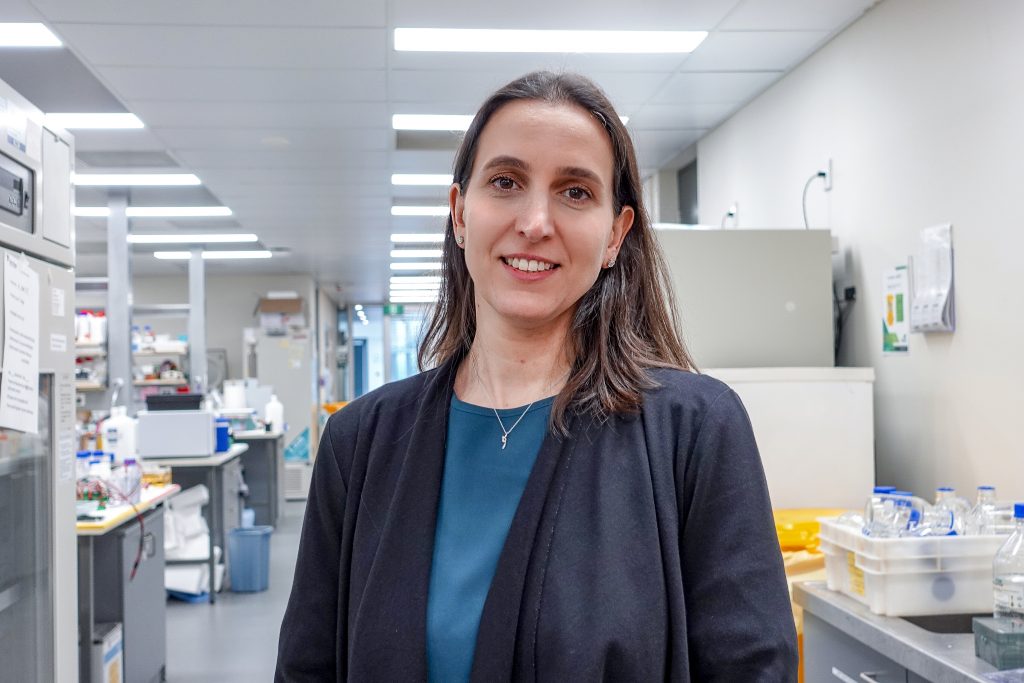Detecting hidden heart attack risks in women under 50
The risk of sudden, unexpected heart events in women may be identified far earlier due to research funded by NSW Health, to help discover genetic links and guide more tailored medical management.
When she suddenly experienced a life-threatening heart event one Saturday morning, Liza Stearn, then 42, was shocked, because she was fit, healthy and had no obvious risk factors. “I was out viewing a house for sale when I started feeling faint,” says the now 50-year-old Sydney travel consultant. “When I broke out in a cold sweat, I thought I might be coming down with a virus. But soon after that, I felt a very sharp pain in my left arm, which started to also feel numb.” Her husband quickly called an ambulance. Minutes after it arrived, Stearn went into cardiac arrest. She had no pulse or heart rate, but the paramedics saved her life by administering CPR, medication and seven defibrillation shocks, to kickstart her heart again.
The silent heart condition affecting women
Tests later showed that Stearn had experienced a heart event called SCAD (Spontaneous Coronary Artery Dissection). “It is caused by a tear in one or more of the arteries, which reduces or blocks blood flow in the heart,” says Associate Professor Eleni Giannoulatou, who leads the Computational Genomics Laboratory at the Victor Chang Cardiac Research Institute, where she is currently researching SCAD. Though the condition affects males, more females are impacted. SCAD causes around 25% of heart attacks in women under 50 (often around age 45) and 2 to 4 % of heart attacks in women overall. Signs of SCAD vary from mild chest discomfort to common heart attack warning signs. By discovering genetic information to assist in disease prediction, Giannoulatou hopes to better understand SCAD heart events, identify those at risk through genetic screening for women and their families, and contribute to the development of future preventative treatments. For this cutting-edge work, she has received research funding through NSW Health’s Cardiovascular Early-Mid Career Researcher Grant.
Giannoulatou’s work underpins some of the most important Australian discoveries in cardiovascular research in the last decade. In 2016, she joined the Victor Chang Cardiac Research Institute, as a member of the Bioinformatics and Systems Medicine Laboratory. She then formed the Computational Genomics Group, which has different projects on the go, including the investigation of SCAD. “We develop computational methods and mathematical models to help us analyse large volumes of patient DNA data,” she explains. “We use this to identify disease-causing genetic mutations, to increase the current diagnosis rate of genetic cardiovascular disease.” For this research, Giannoulatou draws on her extensive training in computer engineering and informatics, computational biology and bioinformatics. Simply put, this means she uses a range of research models and approaches to analyse genetic information and see genetic patterns linked to disease. Though lifestyle habits can influence heart disease risk, genetics can also play a significant role. “Some forms of heart disease are down to one genetic mutation and others involve several genetic differences or more,” Giannoulatou adds.

What causes SCAD?
The Hollywood heart attack that we see in films, where someone clutches their chest and is rushed off for bypass surgery, occurs due to plaque build-up, which causes a blockage in one or more of the arteries of the heart. SCAD is different and occurs due to a tear in the artery. “The women affected are often fit and sporty and in a low-risk age group for a heart attack,” Giannoulatou points out. “They usually don’t have other typical heart disease risk factors, such as high cholesterol or pre-diabetes. So, when they experience SCAD symptoms, appropriate heart tests are not always immediately conducted and there can often be a delay in treatment.”
As a result, women who experience a Spontaneous Coronary Artery Dissection may be at higher risk of losing heart muscle during an undiagnosed SCAD event. Or they may have a small tear in their artery go undetected for years until it gets bigger and leads to a life-threatening blockage or heart arrhythmia.
“When I woke in St Vincent’s hospital after five days in a coma, I couldn’t believe I’d had such a close call,” says Stearn. “I had no family history of heart disease and I was a very fit and active person – regularly running and swimming and doing other outdoor activities like kayaking and camping. Luckily, the quick work of the paramedics meant that my heart muscle was only slightly damaged.”
Though the exact causes of SCAD are still not well understood, research shows a clear genetic link to the condition. “There are also some known triggers,” says Giannoulatou. “Women with this genetic vulnerability may suddenly have a heart event after intense emotional or physical stress, or extreme exertion, which can place greater pressure on the heart’s blood vessels. Childbirth can do the same, and together with hormonal changes, can increase the risk of an unexpected SCAD incident days, weeks or even months after a woman has given birth.” Peri-menopausal and menopausal changes may also be linked to some SCAD events. Yet, most women are not aware of their SCAD risk until the arterial tear occurs and causes a blockage.
Developing a DNA databank
The Victor Chang Cardiac Research Institute currently has a DNA bank of 500 registered people (mostly women), who have experienced SCAD events. Through international collaborations, the team also has access to information from other labs and research relating to 2,000 people with SCAD. “This is still not a very high number for genetics research, so we are trying to increase that database,” Giannoulatou points out. “NSW Health funding has helped us identify 10% of cases that involve genetic variants. It allowed us to put together a multi-disciplinary team involving cardiac specialists, genomic data analysts, clinical geneticists, and scientists who specialise in functional genomics, which means they can help us validate our findings through doing experiments in a lab setting.”
Further work by Giannoulatou and colleagues has revealed that women with migraine, stroke and hypertension may be more at risk of SCAD events. “This has been very important and helpful information,” she says. “The team are now hoping to investigate the DNA of women with migraines and high blood pressure, to identify any gene differences that may predispose some people in this group to a SCAD heart attack.”

Answering genetic questions about SCAD
“I am on a mission to develop more sophisticated methods to find genetic mutations, and also look for them in less obvious places,” Giannoulatou explains. “The most satisfying part of my work is analysing DNA data that hasn’t been seen before and looking to see if it can explain our genetic questions.” This approach led to her breakthrough in identifying genetic links to certain miscarriages and also some heart defects in newborn babies. This paved the way for her colleague Professor Sally Dunwoodie, to discover that vitamin B3 has great potential to treat the molecular deficiencies that contribute to these issues.
As a result of her impressive research relating to heart disease, in 2022, Giannoulatou received the NSW Health Ministerial Award for Rising Stars in Cardiovascular Research. Now, she has her sights set on SCAD. “Most people directly know someone or know of someone who has experienced a heart attack or developed cardiovascular disease,” she says. “As it’s the most common cause of death in Australia, I feel very passionate about being part of a generation of researchers who can predict, prevent and diagnose cardiovascular disease.”
Detecting women at risk of heart events
When adding a person to the SCAD database, the research team collect information about their medical history and the circumstances leading up to their SCAD. In addition to providing medical information, participants submit a DNA sample via a simple mouth swab. “As 99.9% of DNA is identical between any two people, the differences help determine why people experience certain health conditions,” says Giannoulatou. “Some of these differences are very common and are present in people all over the world, while others are very rare and may only be present in one person and their nearest relatives.” Giannoulatou’s team is looking at both types of differences in DNA to determine which genes may contribute to a person’s SCAD risk.
“Identifying these genetic variants is very important because we can then pinpoint family members at risk – for example we’ve had families where one woman has experienced a SCAD event and then we discovered her sisters carry the gene variation too,” Giannoulatou explains. In order to identify more common gene variations that predispose to SCAD, Giannoulatou compares the DNA of those who’ve had a SCAD heart event with the genetic variants of people who don’t have a history of major health conditions. “Those are our ‘controls’ and they are people whose DNA was sequenced by the NSW Medical Genome Reference Bank, in older age (between 64-95 years) because they have no cardiovascular disease, no cancer and no hypertension,” she says. “This comparison process has helped us identify 17 different locations in the genome that increase risk of SCAD and we know there are more we have yet to determine.”
Once a person is identified as having a genetic risk of SCAD, they might then obtain baselines of certain health indicators such as blood pressure and also have more regular heart health checkups. Based on this information, those individuals in consultation with their doctor, may consider various options, including lifestyle changes (such as avoiding high exertion exercise) and medications.
Life after a SCAD heart event
After one SCAD event, there is a 20% chance that a woman might have another. Treatment often involves taking drugs to lower blood pressure and thin the blood. Though the tear itself heals up, usually within a few months, stents (small tubes) or angioplasty (small balloons) may need to be surgically placed in the heart to help keep arteries open.
Stearn found the first six months after her SCAD event very challenging. “I was exhausted and my body was adjusting to taking numerous medications,” she recalls. “I was in pain from the broken ribs due to the defibrillation to restart my heart. I was also unable to drive and walking felt like a huge effort. It was a very emotional and nerve-wracking time, as for a while, every little twinge or pain I had in my chest made me worry that I could be having another heart attack.”
Eight years later, Stearn has not had another SCAD heart event. Meanwhile, the experience radically changed how she lives her life. “As a working mother I used to juggle a lot of balls and feel quite stressed all the time, but now I try not to rush and I ensure I relax, rest and meditate more,” Stearn says. “Since the heart attack, I have been doing really well and I’m in very good health. I’m also very glad that research is being done in this area. Hopefully, in the future, genetic screening will help alert women like me to their SCAD risk so that they can be regularly checked, have preventative treatment and make any lifestyle adjustments that can help reduce their risk of a sudden SCAD heart attack.”
Updated 1 year ago